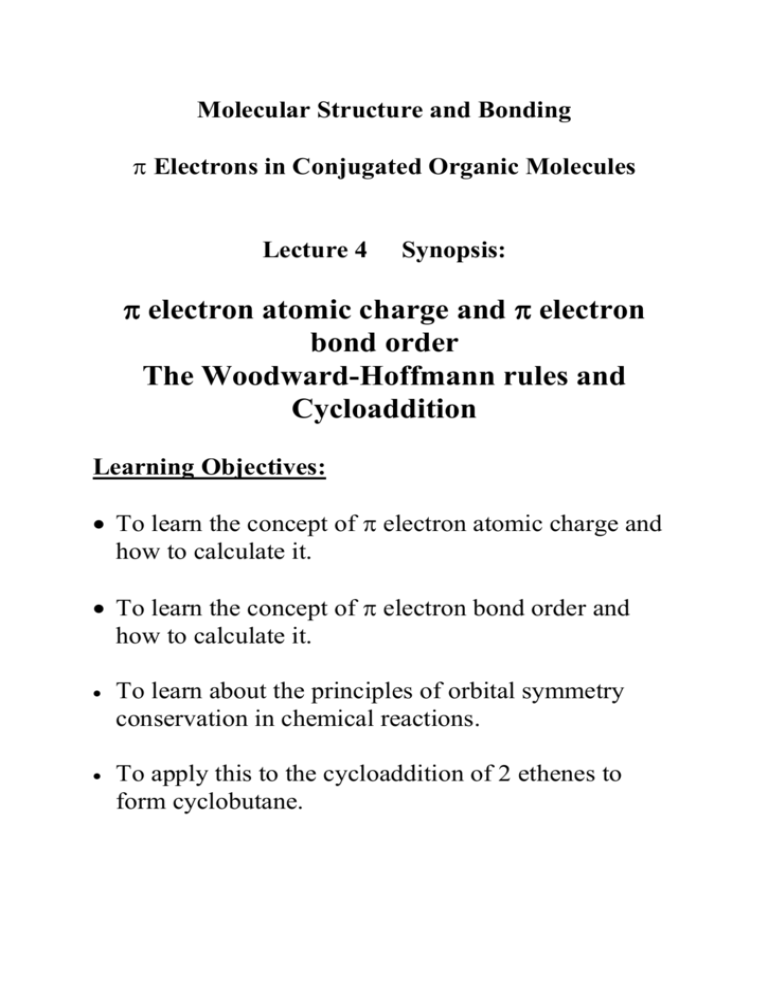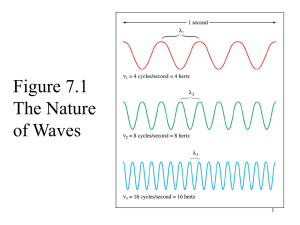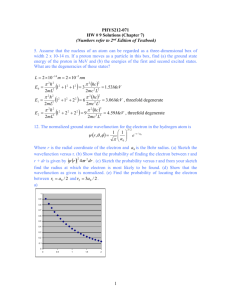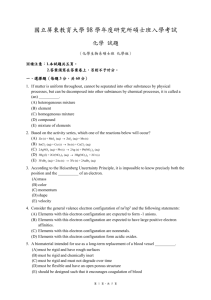lect41_htm
advertisement

Molecular Structure and Bonding Electrons in Conjugated Organic Molecules Lecture 4 Synopsis: electron atomic charge and electron bond order The Woodward-Hoffmann rules and Cycloaddition Learning Objectives: To learn the concept of electron atomic charge and how to calculate it. To learn the concept of electron bond order and how to calculate it. To learn about the principles of orbital symmetry conservation in chemical reactions. To apply this to the cycloaddition of 2 ethenes to form cyclobutane. To learn how to assign symmetries to the MOs of reactants and products and to draw a correlation diagram which relates them. Ian Fleming “Frontier Orbitals and Organic Chemical Reaction”, Chapter 4. R.B. Woodward and R Hoffmann “Conservation of Orbital Symmetry”. pages 1-64 electron atomic charge: The coefficients in the molecular orbitals reflect the charge distribution of an electron in that orbital. i ci11 ci 22 ci33 ci 44 i: Molecular orbital number ‘i’ 1: atomic (p) orbital on atom 1 1: atomic (p) orbital on atom 1, etc. in the coefficients cia i ----- is the molecular orbital number 2 a ----- is the number of the atom and of corresponding atomic p- orbital. If there is an electron (just 1) in molecular orbital i the charge distribution corresponding to this electron is given by: r i r ci21 1 2 r 2ci1ci 21r 2 r ci22 2 2 (r): Charge distribution (electron density) -- this is a function of position r -- arises from 1 electron in M.O. “i” The electron density is a function of the coordinates. Its value changes with position in space. In the example above, ci12 is a measure of the amount of charge on atom 1 - arising from 1 electron in MO i. 2ci1ci2 is a measure of the charge shared between atoms 1 and 2. electron charge on atom a (qa): 3 ni cia qa 2 i sum over all occupied MOs ni is the number of electrons in MO i. If the occupied molecular orbitals all have 2 electrons in them then ni=2 and the equation for the atomic charge becomes; 2 cia qa 2 i sum over all occupied MOs electron bond order: We can also define a quantity which measures the strength of a -electron bond between two atoms. This quantity depends on the electron density which is shared between two atoms: electron bond order for a-b bond (pab): 4 pab ni cia cib i sum over all occupied MOs again ni is the number of electrons in molecular orbital i. If all the occupied molecular orbitals have two electrons in them then all the ni = 2 and: pab 2cia cib i sum over all occupied MOs 5 For 1,3-butadiene we obtain: q=1 q=1 q=1 q=1 CH2 CH CH p = 0.45 CH2 p = 0.89 p = 0.89 q=1 q=1 q=1 q=1 CH2--------CH--------CH---------CH2 p=0.89 p=0.45 p=0.89 For ethene we obtain: q=1 q=1 H2C------------CH2 p=1 Conservation of orbital symmetry: cycloaddition of two ethenes to form cyclobutane--- Introduction to correlation diagrams: 6 R.B. Woodward and R Hoffmann “Conservation of Orbital Symmetry”, pages 1-64 -- They were awarded the Nobel prize for this! We examine the following aspects of a chemical reaction: 1) The symmetry of the reactants and products: can we identify any symmetry elements which are present throughout the reaction? These are things like axes of symmetry or planes of symmetry. 2) Identify the molecular orbitals which participate in the reaction. Some molecular orbitals, such as some C-H bonding MOs for bonds which are not broken, are clearly not involved. Include the antibonding orbitals corresponding to the highest few bonding orbitals involved. 3) Assign symmetries to the MOs of A) Reactants B) Products. 4) Draw a correlation diagram. This is done by joining up the lowest orbital with a particular set of symmetry attributes on the Reactant side with the lowest MO with the same symmetry attributes on the Product side. This is a correlation diagram. 7 5) From this correlation diagram we will be able to see if there is a barrier to the chemical reaction or not. If the occupied MOs increase in energy there is a barrier. 8 Cycloaddition of 2 ethenes to form cyclobutane (ethene dimerization) We consider coming together so that their orbitals overlap. This is the pathway for the reaction: + i.e. Mirror plane H H H H H H H H H H H HH H HH Twofold rotation axis (C2) Two symmetry ELEMENTS (a two-fold rotation axis, C2, and a mirror plane) are conserved throughout the reaction - they are present in the reactants (two ethenes) as they approach one another, and also in the products (and in the transition state of the reaction). These symmetry elements are shown above for the reactants and the products. There are other symmetry elements, 9 but we will consider only the minimum number we need to analyse the reaction. We must now classify the symmetries of the orbitals of the reactants and the products with respect to these symmetry elements. We must consider the combinations of the orbitals for their symmetry properties (e.g. the MOs of one ethene alone don’t have these symmetry elements). The combined MOs must be either symmetric (S) or antisymmetric (A) for each symmetry element. 10







